 |
| Li Mingzhu with Currency |
There were other divine encounters in Beijing on that sunny day. We had left so early to reach the Cao Chang Di District, that we had 45 minutes before entering Ai Weiwei’/s compound, which is watched 24/7 by surveillance cameras, so Mia Yu, our art guide, and an expert on the contemporary movements in China, walked us to another studio within a couple of blocks, that of Li Mingzhu, who with his new show “What Are You Looking at?” He means to raise eyebrows and find out how you see things. He is an advocate for truth, saying “Milk is contaminated, Capsules are made from boots, Lean pork is from swine feeding on chemicals, cooking oil is recycled from leftovers, fruits and vegetables are grown with artificial plant hormones. We are in big troubles. By consuming food we are potentially spending our money to get sick.”
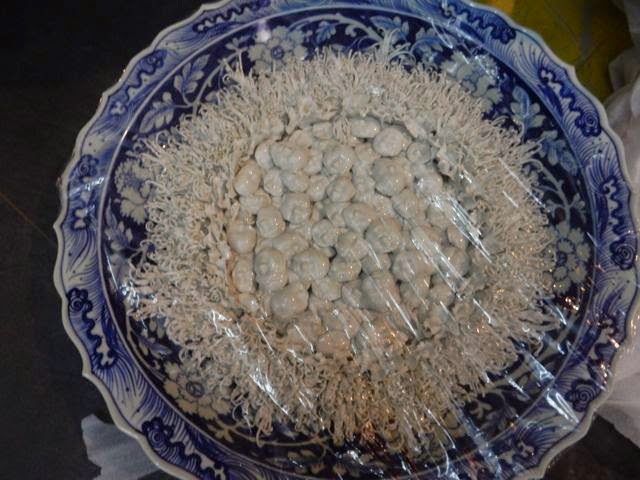 |
| Li’s plate of Mao Heads |
In his ample studio was a chair so large there wasn’t much room for anything else, in such contrast to his interest in the fragile relics of history. On a low table were sets of plastic bananas, ceramic water pitchers from history, and ax handles. He too is concerned with duplicity, binding himself with other artist who use their skills to protect conditions. He too feels freedom of expression is soul and speaks through many mediums (installations, sculpture, ceramics, painting, drawing) to meet challenges pushed into the world out of Chinese history. What caught my eye was a giant blue and white porcelain plate filled with white porcelain noodles and tiny “rocks” of Mao ZeTung faces. And he also had made metal shoes to which he attached glazed horse hooves used for scraping backs in days gone by.
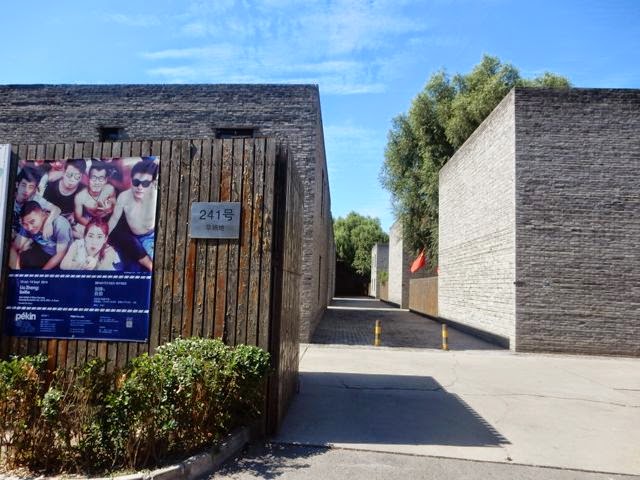 |
| Meg Meggio’s Gallery |
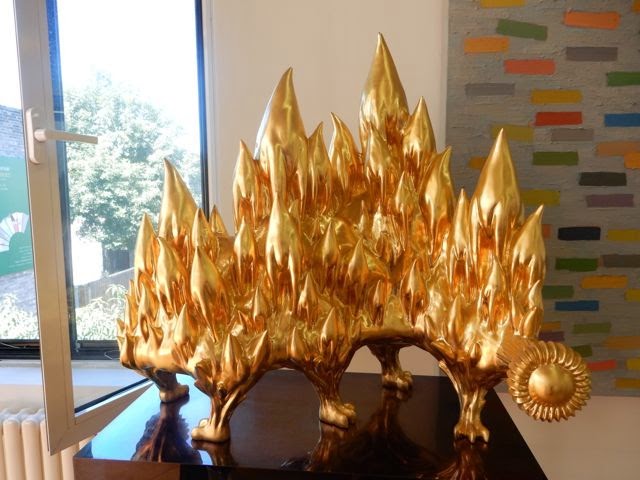 |
| Meg’s Golden Fire series |
His favorite thing is to visit the Ghost Markets – this happens after midnight, when lights are low, and probably illegal sales of contraband happens, like 3 in the morning, in the dark. Li handed us pink flashlights he had designed as gifts. In the market, he finds amazing pieces of history, from the early dynasties thru toil and trouble to the 20th century – a fragment of a porcelain pot, a opium holder made with silver coins, parts of tools, a piece of jade, and so on. He takes up each treasure and hopes to create a bargaining moment when he will sell the tiny items for kilos of rice to give to the poor.
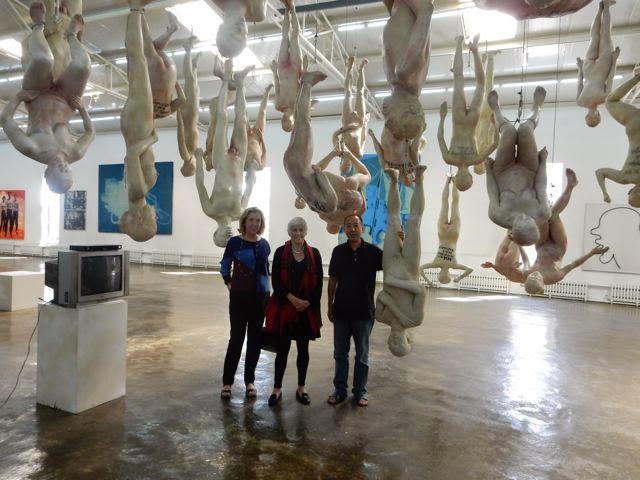 |
| At Zhang Dali’s work space |
After my Ai Weiwei meeting, Mai led us to the gallery of Meg Maggio, an American art dealer who really has her finger on the pulse of Chinese contemporary art. She shows artists from all over Asia but originally arrived in Beijing as a corporate lawyer. Now she has reached the category of “Authority.” Her gallery, Pekin Fine Arts (designed by Ai Weiwei), houses cutting edge exhibits. She is an encyclopedia of who’s who in the art world, and what the problems and benefits of contemporary Chinese Art contain. She talked about the First Wave of artist who became millionaires abroad, often called the Get Rich First group, or something similar. And now the younger wave is moving up with less international gain but definitely keeping Chinese art in the running for the best things happening in art today.
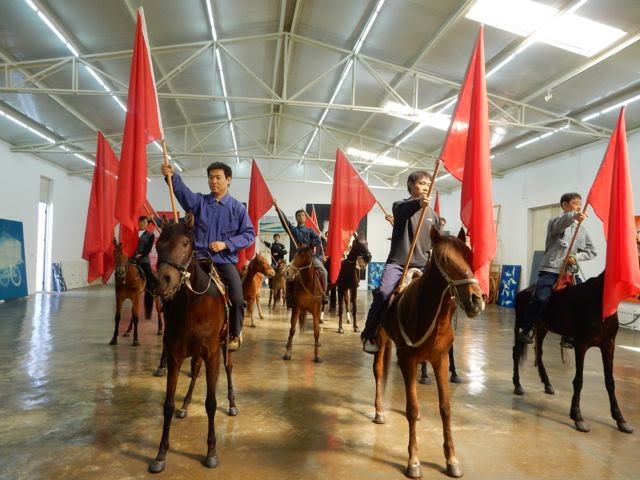 |
| Zhang’s Brigade |
In the afternoon we stopped by the studio/home also in the area of Zhang Dali. Oh My Gosh! His space is an enormous barn and many of his most controversial pieces reside there. We walked into a bevy of bodies hanging upside down called Chinese OffSpring, and he actually used migrant workers to cast his molds and then hung them upside down in galleries to emphasize the low social status they have in China, still. Dali is a quiet mannered man as well, who uses every kind of media to get his point across – the president day social ills.
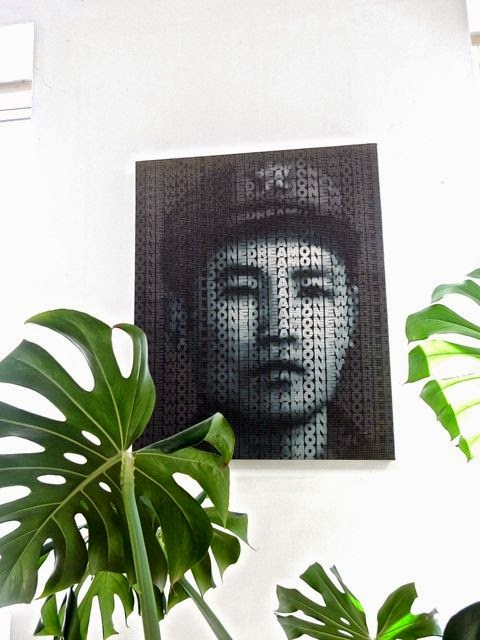 |
| My favorite of Zhang’s pieces |
He, like Weiwei, believes the artist responsibility is to bring to fore the ordinary people, the faceless migrant workers, and the poor. He rose to fame in the 1980s after his own struggling years, and broke into the art scene when he drew a familiar silhouette of a face on all sorts on walls and structures ( a protest graffiti) destined for destruction. It was called Dialogue and Demolition. He said in a catalogue, (he doesn’t speak English in depth), that “In China violence exists somewhere between habit and apathy.” While migrant workers contribute to the economy and make things “go”, they have no rights or protection, so they are abused. That sways them to resort to the violence they know day to day.
 |
| Zhang’s Donkeys |
His installation of the Brigade called “Wind – Horse – Flag ” actually uses more models he made from human bodies, plus horses which have been formed at a taxidermist. For a horse person like me, it was a shock on first seeing it, but then I began to think why don’t we honor important horses who have struggled and entertained man since they stepped ashore. These animals are visually shocking, almost battered with crude taxidermy stitches showing. There is also a bronze sculpture of himself holding a AK-45 to his head, an this inspired a series of images of young soldiers of the Red Guard using the works AK-47 or One World One Dream (the Olympic theme). He was so relaxed and we wandered through his home and studio where he lives surrounded by his work. On one wall, really shocking, were two giant half heads with mouths wide open out of which donkeys are trying to crawl. Now that’s a take on our national politics.
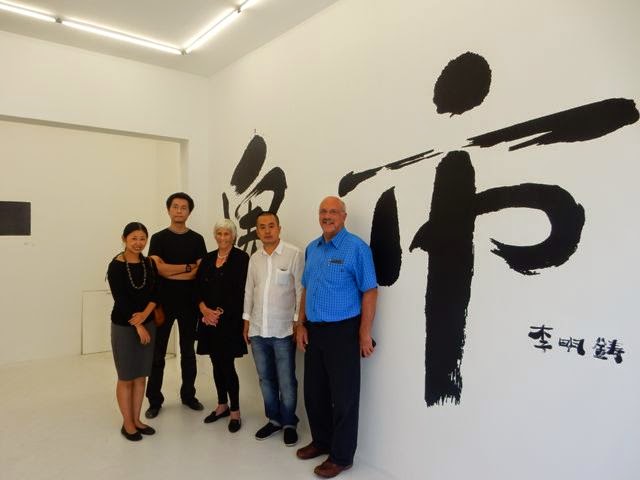 |
| A good gang for ghost market |
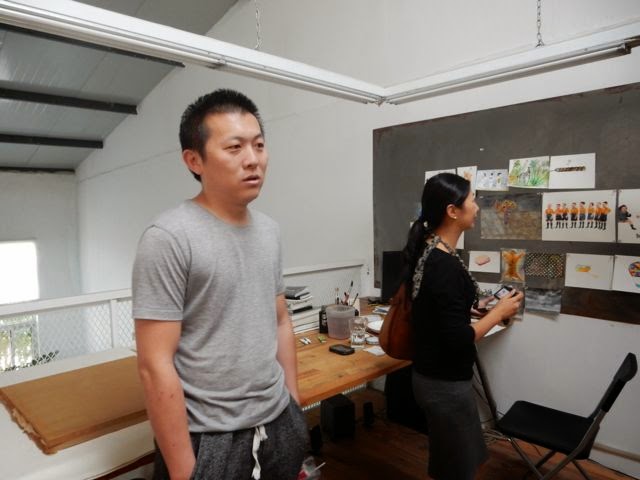 |
| Young artist in Black Bridge |
We traveled to an area called Black Bridge Arts Community where Beijing’s young artist survive as simply as possible. Rent is $5000 a year for a fairly decent space to work an live in. There are over 100 artists studios which vibrate with new thought and method. They have mini-gardens growing in tiny plots of dirt so they can eat vegetables and many are trying to revive the traditional Chinese art use of ink – and one young man placed sheer silk on a frame and drew delicate insects across it, so it was transparent but also vibrant. They welcomed us as casually as if they had known us for years, but that was also because of those who were with us. Sadly I have a hard time remembering the names since my Chinese is limited to she-she (thank you.) But the emotional journey visiting these artist gave hope for what is to come. We even met a female artist.
 |
| Sheer silk for canvas |
The day was not done, although I felt I’d run a marathon. What wears on the soul is having to spend hours and hours in traffic that doesn’t move or if it does, is a case of dodging all the other drivers who make left turns across the lanes, and do turn arounds in the middle of traffic. Ugh. But we were scheduled to meet Yang Erche Namu who is famous for being the last leader of the Muoso matriarchy. We met at a very ornate Tibetan restaurant where the music was shouts on the microphone, since a show of Tibetan customs and songs was in progress. Namu lives close to the Tibetan border and she is one of China’s unique personalities.
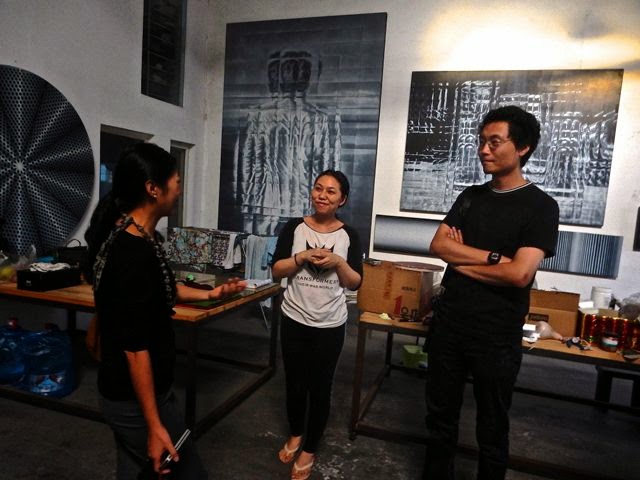 |
| Visiting studios |
She arrives in shocking pink, lime green and red shorts with matching ostrich hide purse and has long black hair. She hands me a silk scarf with her image on it. And was greeted by the owners of the restaurant as we were draped in holy scarves that we must pass on to others during the night. Author of many novels, a judge at the China American Idols (She’s the Simon on the show) and a famous singer, she spent much time in the US. She does not long for the rural life where she grew up as a child. But we are expecting to meet up with her again when we go to Lijiang in weeks to come since we just could not hear much of our conversation with the shouts and screams and ballads coming from the stage in front. Then I will be able to talk more about the “walking marriages” and MUOSO life, of which she has been a matriarch and a part.












